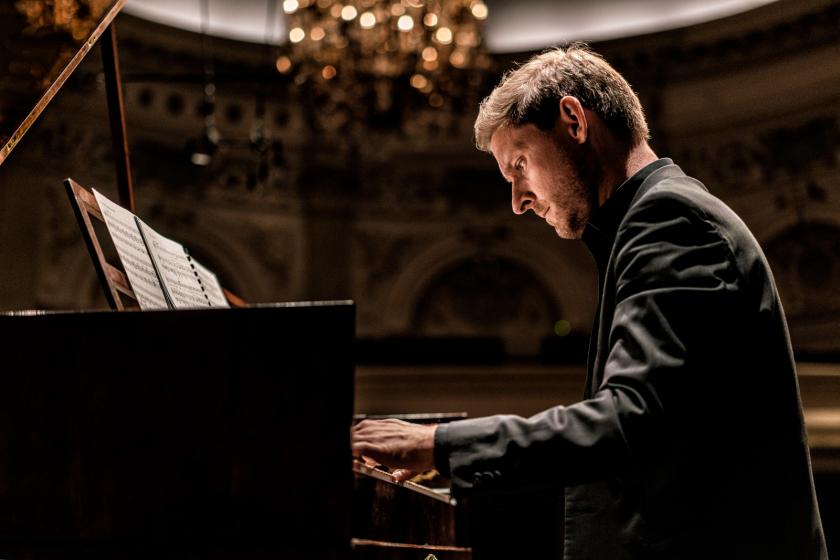An evening of Mozart favourites in a landmark church on a sunny evening: that might suggest a perfect recipe for gently soporific tourist entertainment. Thankfully, not in the hands of Kristian Bezuidenhout and the English Concert. At St Martin-in-the-Fields, the South African-born Australian virtuoso of the period keyboard joined the Baroque orchestral powerhouse with which he collaborates as principal guest. Together, they stripped the varnish, and shook the dust, from two treasures whose sheer familiarity can render them in some way inaudible. The Jupiter Symphony, prefaced by the piano concerto no. 20 in D minor, emerged from their late-spring clean fresh, sparkling and as thrillingly original as they should always sound. Forget those irresolvable questions of “authenticity”. Zest, panache and excitement, which we enjoyed in abundance, ought to be enough.
Bezuidenhout’s bright, brittle, bell-like fortepiano will never satisfy romantic Mozartians for whom only the shaded half-tones of a fully-pedalled concert grand can suffice. Neither will his hyperactive style of direction from the keyboard please buffs of historically-informed performance who prefer their scholarly guides to be heard but not much seen. Yet the high-energy, high-definition approach of both conductor-soloist and orchestra suited setting, repertoire and occasion. Anyone who came to St Martin’s to be soothed by bland old friends would – or should – have been jolted upright by the revolutionary forces of Mozart’s music of the future.
 Bezuidenhout began with the brief overture to the 1786 comic singspiel, Der Schauspieldirektor. The prelude to Mozart’s satirical squib about outsize showbiz egos allowed this particular Direktor to trial his expansive, 360-degree gestures from the keyboard. Meanwhile, the 30-strong English Concert (pictured above) unveiled the swagger and brio that would drive the whole bill. Next, in the tense, expectant and brooding allegro of the D minor concerto, the fortepiano showed its peculiar mettle while soloist-conductor swung and jumped from his stool to coax a change of dynamics, or a knife-sharp entry, from the band.
Bezuidenhout began with the brief overture to the 1786 comic singspiel, Der Schauspieldirektor. The prelude to Mozart’s satirical squib about outsize showbiz egos allowed this particular Direktor to trial his expansive, 360-degree gestures from the keyboard. Meanwhile, the 30-strong English Concert (pictured above) unveiled the swagger and brio that would drive the whole bill. Next, in the tense, expectant and brooding allegro of the D minor concerto, the fortepiano showed its peculiar mettle while soloist-conductor swung and jumped from his stool to coax a change of dynamics, or a knife-sharp entry, from the band.
Bezuidenhout’s playing ensured that the solo part never felt narrow or crimped in tone. Rather, his reading of the concerto had an edgy, angular and surprisingly forceful quality. The fortepiano timbre, however, did alter the balance of his dialogue with the excellent English Concert strings, impressively led throughout by Nadja Zwiener. Their interplay had a dramatic, egalitarian give-and-take not always present with the sumptuous, lingering resonance of a modern grand. Bezuidenhout has spoken (in a recent New Yorker profile) of how period-keyboard Mozart encourages the player not to rein things in but thrust them out: these notes, after all, will not hang around for long, so each one must really count. With that (relative) sonic fragility came a consistent sense of urgency and drive.
The slow-movement Romanze, however, showed that Bezuidenhout’s period-style vehicle could still travel with grace and elegance. His airy, wistful and properly dreamy phrasing meant that few listeners would have pined for lusher legato textures, as the orchestra proved a keenly responsive partner in calm and stormy scenes alike. As for the bite and fury of the closing rondo, Bezuidenhout’s rhythmic agility and dashing passagework matched some grippingly emphatic tutti from the orchestra. There was no lack of firepower here, in an interpretation that never felt short on expressive range – despite the fortepiano sonorities that delivered glittering brilliance, rather than radiant bloom.
 For the Jupiter Symphony, Bezuidenhout sat, or stood, at his instrument, facing the orchestra. From time to time he swooped down on the keys to add touches of continuo. Lithe, brisk and bouncy, the English Concert – with all the strings now standing – skipped and punched through the opening allegro with panache. However, I felt on occasions that Bezuidenhout’s acrobatics were starting to look like too much of a good thing. No one wants a leaden time-beater, but the orchestra exhibited quite enough spring and bustle without all the director’s gymnastic routines. So the reflective stillness of the andante came as a relief, even if its cantabile marking sometimes got lost in the mix.
For the Jupiter Symphony, Bezuidenhout sat, or stood, at his instrument, facing the orchestra. From time to time he swooped down on the keys to add touches of continuo. Lithe, brisk and bouncy, the English Concert – with all the strings now standing – skipped and punched through the opening allegro with panache. However, I felt on occasions that Bezuidenhout’s acrobatics were starting to look like too much of a good thing. No one wants a leaden time-beater, but the orchestra exhibited quite enough spring and bustle without all the director’s gymnastic routines. So the reflective stillness of the andante came as a relief, even if its cantabile marking sometimes got lost in the mix.
Buoyancy and effervescence returned with a delicious minuet, after which the interwoven fugato motifs of the torrential finale showcased a wonderfully cohesive outfit on peak form. Bezuidenhout jumped, crouched and skipped as he kept the show on the road in top gear (and at high speed). His histrionics may have distracted, but they did achieve results. Lovely flourishes from woodwinds and brass (horns above all) complemented Zwiener and her fierce, tight strings. Bezuidenhout found relentless momentum but also crystal-clear articulation. This luminous music-making did not entomb Mozart in some “period” crypt, but set him free to dance through the endless June twilight.















Add comment